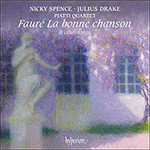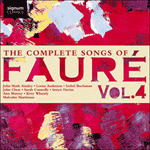This is one of the songs that Poulenc most hated hearing sung by female singers (Duparc’s
Phidylé was another) because of its unambiguously masculine text. Like
Le secret the poem is from Silvestre’s
Le pays des roses. Both the courtly words and the music bring to mind the Gounod setting
Ô ma belle rebelle, a sixteenth-century evocation with a poem by Jean-Antoine de Baïf. The pattern of Gounod’s accompaniment is a single left-hand note in the bass clef followed by three in the treble, an alternation between left and right hand that suggests the strumming of lute or guitar; Fauré follows suit. In
Chanson d’amour we thus have an exercise in the composer’s celebrated madrigal style, gracious time-travel that transcends pastiche by taking the refined musical manners of an earlier age and incorporating them into the pudeur of his own style (Reynaldo Hahn was to do exactly the same thing). In this music we detect the origins of Fauré’s ‘Venetian’ settings of Verlaine. As is often the case with this composer this is recherché music of the greatest subtlety that is only pretending to be simple. Hundreds of inadequate performances have rendered this
fausse naïveté merely banal by babbling through the song without registering the harmonic nuances, the flirtations with the harmony, and the series of enharmonic puns that Fauré incorporates into the music. The addition of a musical strophe by re-using Silvestre’s first verse is a rare instance of this composer expanding, rather than cutting, a poem. The enjambment, without a breath, between ‘rebelle’ at the end of verse 3 and ‘J’aime tes yeux’ beginning verse 4 is a charming salon touch in a song where every perfectly placed note betokens a smiling composer of the deepest seriousness.
from notes by Graham Johnson © 2005
À cause de son texte masculin, dénué de toute équivoque, cette mélodie est, avec
Phydilé de Duparc, une de celles que Poulenc détestait le plus entendre chanter par une femme. Comme
Le secret, ce poème est extrait de
Le pays des roses de Silvestre, et ses paroles courtoises, ajoutées à la musique, rappellent
Ô ma belle rebelle de Gounod, une évocation du XVIe siècle fondée sur un poème de Jean-Antoine de Baïf. Pour son accompagnement, Fauré reprend le schéma instauré par Gounod, savoir une seule note à la main gauche, en clef de fa, suivie de trois notes en clef de sol—une alternance main droit/main gauche qui suggère le son du luth ou de la guitare.
Chanson d’amour est donc un exercice dans le fameux style madrigalesque du compositeur, un gracieux voyage dans le temps qui transcende le pastiche en empruntant les manières musicales raffinées d’une époque passée pour les intégrer dans la pudeur de son propre style (Reynaldo Hahn devait faire exactement la même chose). Cette pièce nous laisse entrevoir les origines des mises en musique «vénitiennes» de Fauré, sur des poèmes de Verlaine. Comme si souvent chez ce compositeur, nous sommes en présence d’une musique recherchée, extrêmement subtile, qui fait seulement semblant d’être simple. Des centaines d’interprétations inappropriées ont purement et simplement banalisé cette fausse naïveté en bredouillant la mélodie, sans les nuances harmoniques, les flirts avec l’harmonie et tous les doubles sens enharmoniques que Fauré met dans sa musique. L’ajout d’une strophe musicale, réutilisation des quatre premiers vers de Silvestre, est l’un des rares cas où le compositeur a rallongé, et non coupé, un poéme. L’enjambement, sans méme une césure, entre «rebelles» (fin de la strophe 3) et «J’aime tes yeux» (début de la strophe 4) apporte une charmante touche de salon à une mélodie où chaque note, parfaitement placée, révèle un compositeur souriant, empreint de la plus profonde gravité.
extrait des notes rédigées par Graham Johnson © 2005
Français: Hypérion
Chanson d’amour (Armand Silvestre) aus op. 27 stammt aus dem Jahr 1882 und ist voll jenes gewundenen Charmes, mit dem Fauré in dieser Zeit manchmal die anmutigen Schnörkel des Jugendstils zu treffen schien.
aus dem Begleittext von Jessica Duchen © 2025
Deutsch: Viola Scheffel


 Fauré: La bonne chanson & other songs
Fauré: La bonne chanson & other songs Fauré: The Complete Songs, Vol. 4
Fauré: The Complete Songs, Vol. 4
